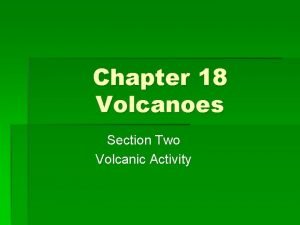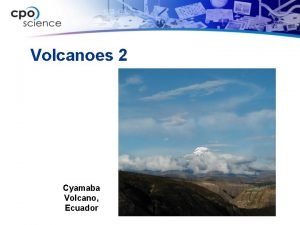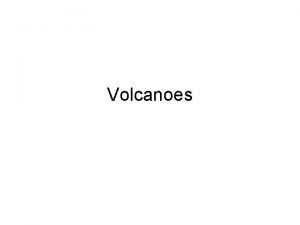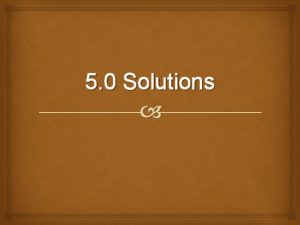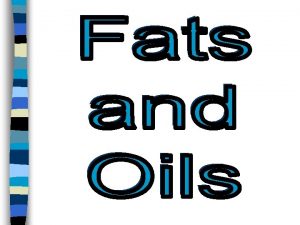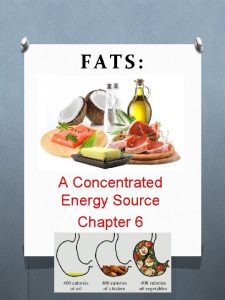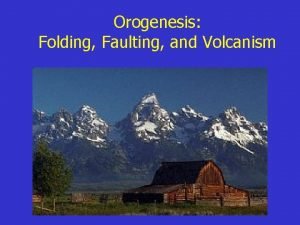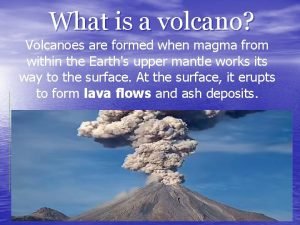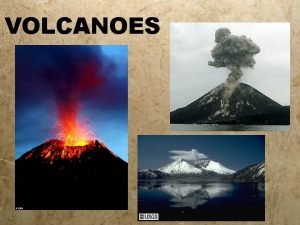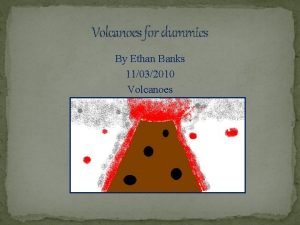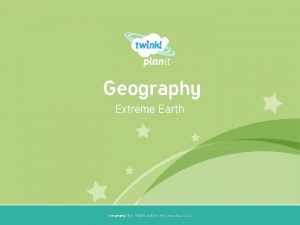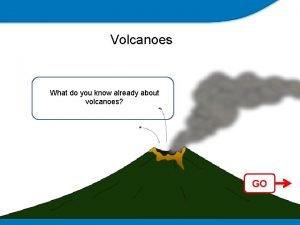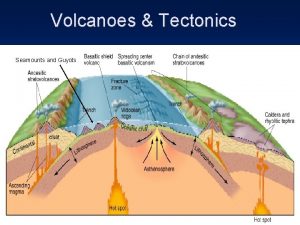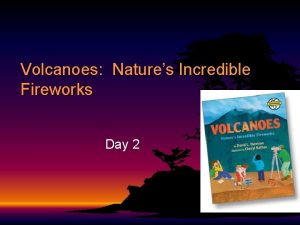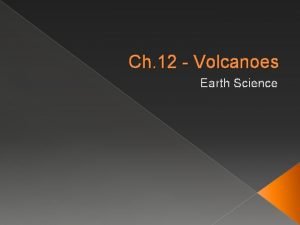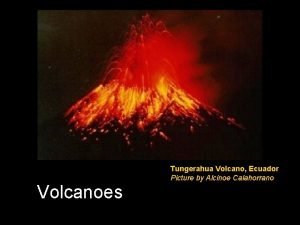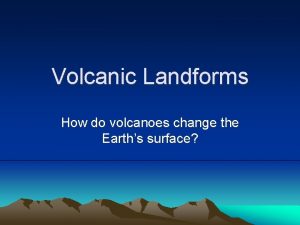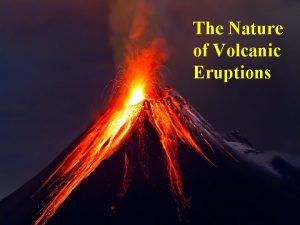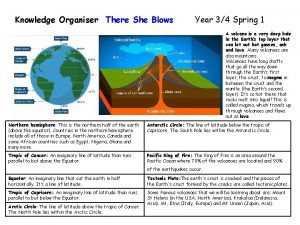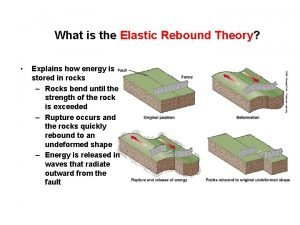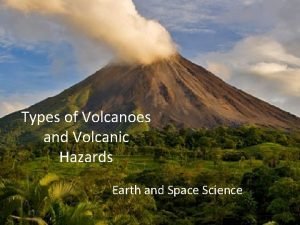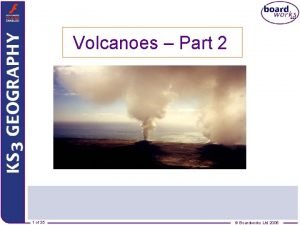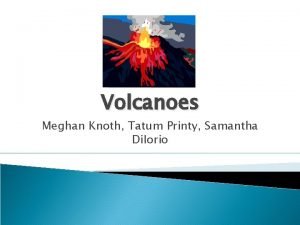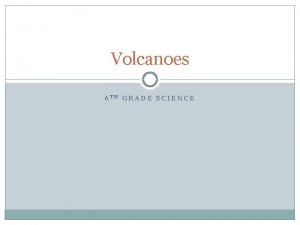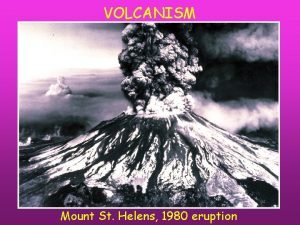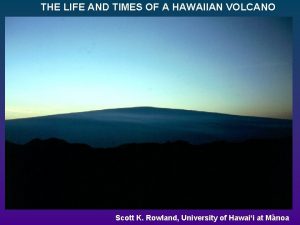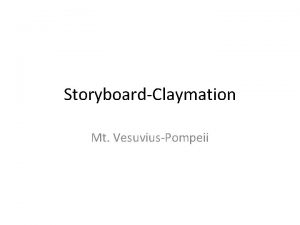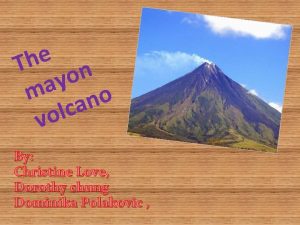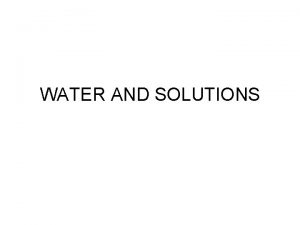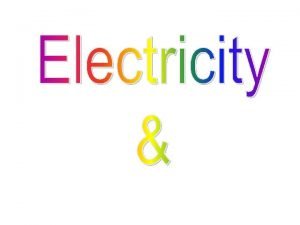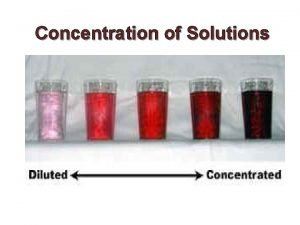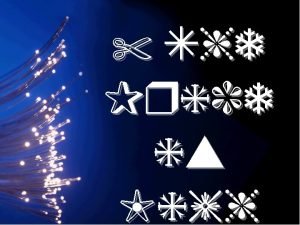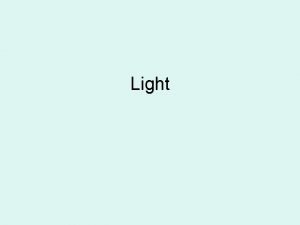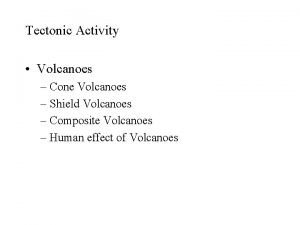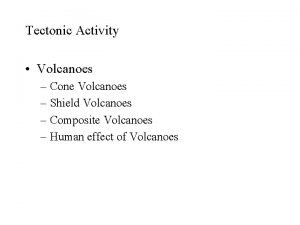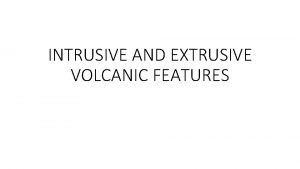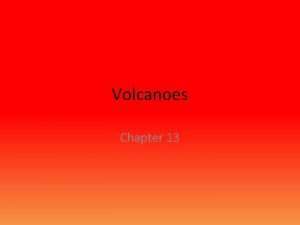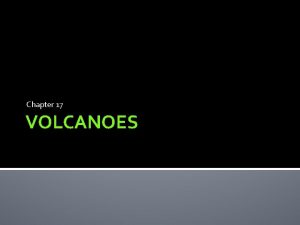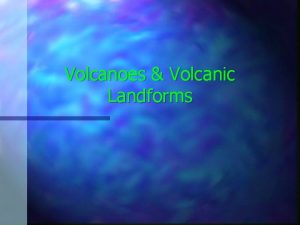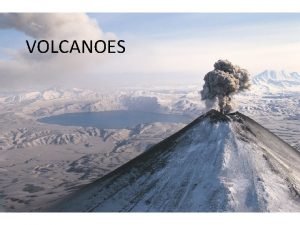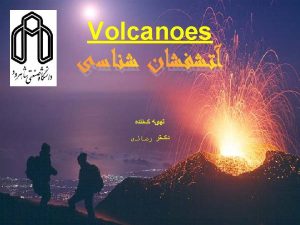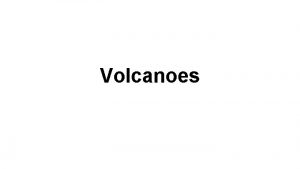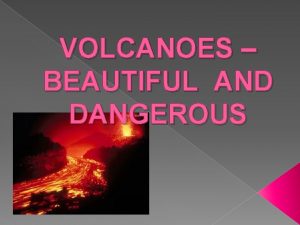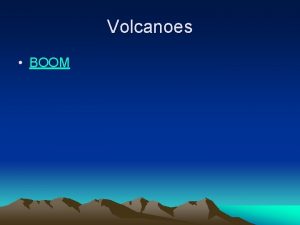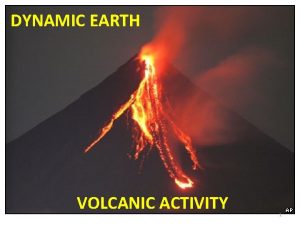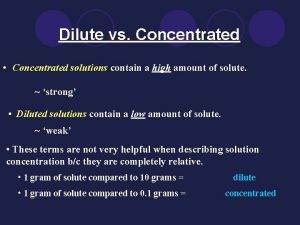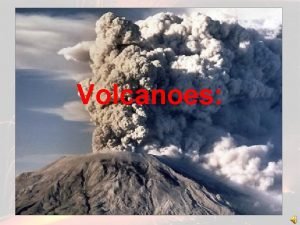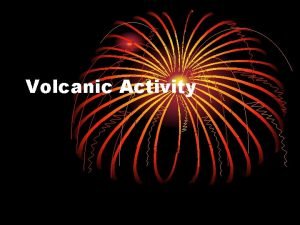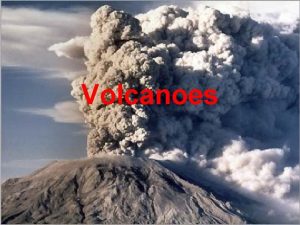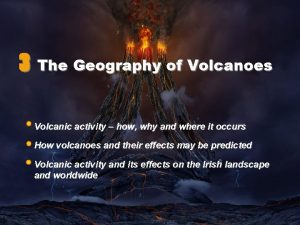Chapter 5 Volcanoes Most volcanic activity is concentrated














































- Slides: 46

Chapter 5 Volcanoes Most volcanic activity is concentrated near plate boundaries

Magma Sources and Types • Magma sources tend to be 50 to 250 km deep into the crust and upper mantle • Temperatures increase as depth increases • Some of the internal heat is left over from the earth’s formation; more heat is generated by the decay of radioactive elements in the earth • Volcanoes are generated at: – Divergent Plate Boundaries – Convergent Plate Boundaries – “Hot Spots”

Figure 5. 2

Magma Sources and Types • Magma compositions vary in Si. O 2 , iron, magnesium, and volatile gases • Mafic magma – low in Si. O 2 (45 -50 %) but high in iron, and magnesium • Felsic magma – high in Si. O 2 (up to 75 %) but low in iron, and magnesium • Intermediate magma – intermediate range of Si. O 2 (50 -65 %), iron, and magnesium • Amount of volatile gases will affect explosive characteristics of eruptions

Magma Sources and Types • Mafic magmas produce basalt lavas – Intrusive equivalent is gabbro • Intermediate magmas produce andesite lavas – Intrusive equivalent is diorite • Felsic magmas produce rhyolite lavas – Intrusive equivalent is granite

Figure 5. 3

Magma at Divergent Plate Boundaries • Magma produced at a Divergent Plate Boundary is typically melted asthenosphere material • Asthenosphere is extremely rich in ferromagnesian (ultramafic) and a melt from it is mafic (or ultramafic) • Basalt is emplaced as new seafloor at the spreading ridge or a rift • Rift systems in continental crust may melt granitic crust and produce andesite or rhyolite lavas – A bimodal suite of extrusive igneous rocks characterize rift volcanoes

Magma at Convergent Plate Boundaries • Magmatic activity at convergent boundaries is complex • The composition of the subducted plate determines the composition of the lava – Subducted continental crust may melt and produce rhyolite lava – Subducted oceanic crust may melt and produce basalt or andesite lava – Subduction of sediments derived from the top of the subducted slab may produce a variety of lavas

Magma at Hot Spots • Magmas associated with a hot spot volcano in an ocean basin will produce a basalt lava • Magmas associated with a hot spot volcano under continental crust generally will produce a felsic lava (and often an explosive one)

Figure 5. 4

Types and Locations of Volcanoes • Seafloor Spreading Ridges – Most voluminous volcanic activity – About 50, 000 km of ridges around the world – Mostly under the oceans - except at Iceland – Generally, harmless mafic fissure eruptions • Continental fissure eruptions – Pour out of cracks in lithosphere – Result in large volume of “flood basalts” – Columbia Plateau (over 150, 000 km 2 and 1 km thick) – Other locations include India and Brazil

Figure 5. 5

Figure 5. 6

Figures 5. 7 a and b

Types and Locations of Volcanoes • Shield volcanoes – – Very large, flat, with abundant thin basalt flows Basalt is less viscous than andesite or rhyolite Shield like shape - larger area relative to height Examples: Hawaiian Island chain • Volcanic Domes – Composed of more viscous andesite or rhyolite • these lavas do not flow – Ooze out onto surface from a tube and pile up close to the vent – Compact, small, and steep sided – Various locations around Pacific Ring of Fire

Figures 5. 8 a, b , and c

Figures 5. 9 a and b

Figure 5. 10 a and b

Types and Locations of Volcanoes • Cinder Cones – Minor explosive volcano – Batches of lava shot into the air as pyroclastics – Size of pyroclastics range from ash (very fine), cinders, bombs, or blocks (very coarse) – Pyroclastics fall close to the vent creating a cone shaped volcano – Example: Particutin, Mexico

Figures 5. 12 a and b

Figures 5. 11 a, b, c, and d

Types and Locations of Volcanoes • Composite Volcanoes (Stratovolcanoes) are built up of layers of lava and pyroclastics – Mix of lavas and pyroclastic layers allows for a tall volcano to form – Usually associated with subduction zones – These tend to be violent and explosive – Example: Mount St. Helens, Cascade Range, Northwest U. S. A.

Figures 5. 13 a and b

Hazards Related to Volcanoes • Lava, the principal hazard? But not lifethreatening generally • Pyroclastics, more dangerous than lava flows • Lahars, a volcanic ash and water mudflow • Pyroclastic Flows - Nuées Ardentes • Toxic Gases • Steam Explosions • Secondary Effects; Climate and Atmospheric Chemistry

Figures 5. 1 a and b

Figure 5. 14

Figures 5. 15 a and b

Figure 5. 16

Figure 5. 17

Figure 5. 18

Figure 5. 19

Figure 5. 22

Figure 5. 23 a

Figure 5. 25

Figure 5. 26

Figure 5. 27

Predicting Volcanic Eruptions • Classification by activity – Active: erupted in recent history – Dormant: no historic erupts but not badly eroded – Extinct: no historic eruptions and badly eroded • Volcanic Precursors – Seismic activity – Bulging, tilting or uplift – Monitoring gas emissions around volcano

Figure 5. 28

Present and Future Volcanic Hazards in the United States • Hawaii: active or dormant volcanoes • Cascade Range: a series of volcanoes in the western United States and southwestern Canada resides above the Pacific Northwest subduction zone • The Aleutians: South-central Alaska and the Aleutian island chain sit above a subduction zone • Long Valley and Yellowstone Calderas

Figure 5. 31

Figure 5. 29

Figure 5. 32

Figures 5. 33 a and b

Figure 5. 34

Figures 5. 35 a and b

Fig. 5. 36 Track of North America across Yellowstone hotspot
 Lava erupts through an opening in earth’s crust called a
Lava erupts through an opening in earth’s crust called a Chapter 18 volcanic activity
Chapter 18 volcanic activity Cotapoxi
Cotapoxi Most volcanoes occur __________. *
Most volcanoes occur __________. * Which solution is the most concentrated
Which solution is the most concentrated Examples of fat
Examples of fat The most concentrated energy source in the body is
The most concentrated energy source in the body is Folding faulting and volcanic activity
Folding faulting and volcanic activity Chapter 8 earthquakes and volcanoes
Chapter 8 earthquakes and volcanoes Crust volcano
Crust volcano How are volcanoes classified?
How are volcanoes classified? Volcanoes for dummies
Volcanoes for dummies How are volcanoes made
How are volcanoes made What do you already know about volcanoes
What do you already know about volcanoes Three main ways volcanoes are created
Three main ways volcanoes are created Volcanoes nature's incredible fireworks
Volcanoes nature's incredible fireworks Lithosphere definition
Lithosphere definition How are volcanoes formed
How are volcanoes formed Active volcanoes map
Active volcanoes map Krakatau volcano
Krakatau volcano Shield volcano
Shield volcano Volcanoes knowledge organiser
Volcanoes knowledge organiser Volcano cutaway
Volcano cutaway Types of volcanoes
Types of volcanoes Ring of fire volcanoes
Ring of fire volcanoes Magma chamber
Magma chamber Lava and magma difference
Lava and magma difference Factors affecting magma viscosity
Factors affecting magma viscosity Name volcanoes
Name volcanoes Where are volcanoes
Where are volcanoes A'a hawaiian
A'a hawaiian Volcanoes of italy map
Volcanoes of italy map Interesting facts about mt mayon
Interesting facts about mt mayon Constructive and destructive forces
Constructive and destructive forces Dilute and concentrated solutions
Dilute and concentrated solutions Poetry is a concentrated thought
Poetry is a concentrated thought Undifferentiated targeting strategy
Undifferentiated targeting strategy Electrolysis of conc h2so4
Electrolysis of conc h2so4 Micro marketing
Micro marketing Washing soda formula
Washing soda formula Multisegment targeting strategy
Multisegment targeting strategy Concentrated targeting
Concentrated targeting Market segmentation targeting and positioning of coca cola
Market segmentation targeting and positioning of coca cola Geographically concentrated buyers
Geographically concentrated buyers String acid
String acid What is ligh
What is ligh What is the light
What is the light

